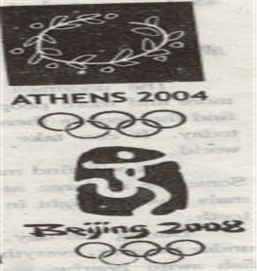

 England, France, Germany, Canada, the USA,
England, France, Germany, Canada, the USA,  pic Games in 2004 was a white circle of olive branches in the sky. People
pic Games in 2004 was a white circle of olive branches in the sky. People 天天向上一本好卷系列答案
天天向上一本好卷系列答案 小学生10分钟应用题系列答案
小学生10分钟应用题系列答案科目:初中英语 来源:同步题 题型:阅读理解
查看答案和解析>>
科目:初中英语 来源:同步题 题型:完形填空
|
查看答案和解析>>
科目:初中英语 来源:同步题 题型:阅读理解
查看答案和解析>>
科目:初中英语 来源:同步题 题型:阅读理解
The Eiffel Tower is beautiful, and a must-see. It is about 1,050 feet high and was the world's tallest
building until 1930. Designed by Gustave Eiffel, it originally had no practical use and was built as a
centerpiece for the World Fair of 1889. Today it is the very symbol of Paris.
It is made of iron and weighs 7,000 tons. It always seems to be so busy around the tower-crowds of
tourists and lots of street sellers selling souvenirs. Visitors can take the elevator to get to the top of the
tower. On the top of the tower, visitors can enjoy the sunset. The sunset is beautiful and amazing.
On the top of the tower, visitors can get a 40-mile view, the twinkling nighttime lights of the city make a pretty sight, but it is difficult to tell from any landmarks (路标).
It is a hugely impressive sight at daylight, but at nighttime becomes magical. It shines with 20,000
lights which sparkle from dusk until 2 am, a real visual (视觉的) treat.
查看答案和解析>>
科目:初中英语 来源:同步题 题型:阅读理解
查看答案和解析>>
科目:初中英语 来源:模拟题 题型:阅读理解
查看答案和解析>>
科目:初中英语 来源:江苏期中题 题型:阅读理解
查看答案和解析>>
科目:初中英语 来源:同步题 题型:完形填空
| 完形填空 "Where is the university?" This is a question that many visitors to Cambridge ask. But no one can give them a l___ answer, for there is no wall to be found 2 the university. The umversity is the city. You can find classroom buildings, 3 , museums and offices of the university all over the city. And most of its members are the students and 4 of the thirty-one colleges. Cambridge was already a (n) 5 town long before the first students and teachers arrived 800 years ago. It grew up by the river Cranta, and the river was once 6 the Cam. A 7 was built over the river as early as 875. So the town got its name "Cambridge". In the fourteenth and fifteenth centuries more and more land was used for college buildings. The town grew much 8 in the nineteenth century after the opening of the railway in 1845. Cambridge became a 9 in 1951 and now it has a population of over 100,000. Many young students in other countries 10 to study at Cambridge. It has become a famous place all around the world. | ||||
|
查看答案和解析>>
湖北省互联网违法和不良信息举报平台 | 网上有害信息举报专区 | 电信诈骗举报专区 | 涉历史虚无主义有害信息举报专区 | 涉企侵权举报专区
违法和不良信息举报电话:027-86699610 举报邮箱:58377363@163.com